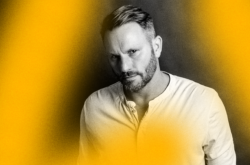An artist who has seemingly touched every genre and corner of online music culture, Ryan Hemsworth is a producer of the information age.
From the international sounds of his label Secret Songs to his collaborations with the likes of Tinashe, Qrion, and E-40, Hemsworth plucks from an array of movements and influences to craft one cohesive sonic palette. Everything from the lush synths of future bass to the gentle kalimba twinkles of lo-fi demonstrate how countless producers are indebted to Hemsworth’s work. “There’s no right way to do any of this,” he says. “People just make their own rules or follow other peoples’.” A tastemaker, sound designer, and advocate for representation, Hemsworth sat down with us to discuss his creative process, new sample pack, and more.
Take us to the very beginning – what was your earliest music like?
Before I knew how to produce, when I was like 13 or 14, it was just guitar and singing. I was genuinely frustrated because I wanted to make music but I didn’t want to sing. Once I started messing with the sounds I was recording, making loops and playing with effects, that’s when it all really became exciting.
What I do now is pretty much just an evolved form of what I was doing when I was 15 – manipulating found sounds, combining elements of my favorite genres, and trying to find a balance with different emotions. That said, I probably have more patience in the process now.
Can you walk us through your studio setup?
Musically / technologically, I have nothing special to show off. Once in a while, I get a new horror movie figurine to add to my table. My monitors are Yamaha HS8s, because they’re pretty and feel accurate to my ears. My audio interfaces are a Focusrite Scarlett 6i6 and a Novation Audiohub 2×4. I use a basic Audio Technica turntable to sample records, and my controller is a Korg microKEY Air 25.
I always want to expand, but I just end doing that digitally. It feels exciting to find new companies making VSTs and plugins. I enjoy spending money on these active companies more than vintage 80s hardware (obviously that stuff can sound amazing, but yeah).
You seamlessly blend mallets, kalimbas, and pianos with electronic elements. What are you using for most of your acoustic sounds?
Yeah I love those sounds – I use a lot of instruments from the lamellophone family. These days I either drag sounds (I record in my room or grab from movies, games, whatever) into Logic’s sampler, or use good old Omnisphere. I think what’s important to me in this process is stacking – mixing soft sounds, organic textures, and instruments with a hard attack, or the opposite. It’s like playing with texture, temperature, spice, and sweetness in food.
Since your early days of flipping tracks by the likes of Kyary Pamyu Pamyu and Frou Frou, sampling has played a large role in your discography. Is crate-digging still a significant part of your creative process?
Yeah I can’t stop sampling – it’s my favorite part of making music. Producers usually go through the struggle of finding their “voice” or their “sound.” I think that if you sample, the palette you choose from is basically your voice. If I produce for a rapper, an R&B singer, or a vocalist from an indie band, hopefully there’s some indication that it’s me through the little sounds or melodies that show up throughout the song.
I’m really cheesy with sampling. A lot of my first album Guilt Trips was made on the road and the songs came from a certain time or mindset, usually some shit I was going through. Although half of them are instrumentals, those are the emotional ones for me because they feature voice memos, audio lifted from videos sent by people who meant a lot to me. I took a lot of those and found ways to make them percussive or melodic to melt them into the instrumental. In retrospect, there’s stuff on there that probably only means something to me, and that can honestly make it hard to listen back to!
Reverbs, delays, and little glitches have always been hallmarks of your tracks. What effects, VSTs, and other tools do you abide by?
I love Valhalla. Their reverbs, delay, and flanger are so fun to play with. I still make a lot of stuff on headphones – for better or worse, I feel like that makes you pretty conscious of space and dynamics. I love Tone Empire’s Goliath for distortion. iZotope has amazing plugins for vocals.
Let’s talk drums. Where do you get your sounds from? Do you play out your rhythms, use sequencers, or drag-and-drop to create grooves?
My sample pack motivated me to finally have an organized place for all of my drum hits. I’ve been using Logic’s Alchemy as a sampler to play drums, but I’ve also definitely just drag-and-dropped samples and then processed them as individual layers. The drum sounds I use are from everywhere, spanning both samples I’ve made and sounds I’ve isolated from songs (J-pop, emo, Atlanta rap, Brazilian music – anything that’s inspiring). Otherwise, I’m dipping from producer drum packs and processing them.
For synths, do you have any particular hardware or software that you gravitate towards?
For synths, I always lean towards stuff from Arturia, Applied Acoustics Systems, Roland Cloud, etc. In particular, I love this synth called Dune lately.
Can you give us some insight into your mixdown process? Are you prescriptive in how you approach mixing certain instruments (bass, synths, vocals, etc.), or are you more about what works within each specific track?
I wish I had an intricate process to explain, but I’ve just been throwing shit at the wall and seeing what sticks for the past ten years. For me, producing and mixing (and mastering, if I self-master a track) happen in the same project file. I guess I try to trust visual mixing as well, keeping an eye on the EQ on all the layers. But overall, I don’t follow too many rules. If it sounds good to make the bass overbearing in a section, or to pan the kicks… then do it? There’s no right way to do any of this – people just make their own rules or follow other peoples’.
Your music navigates many different genres. Do you deliberately choose certain sounds when producing songs in a particular style?
Choosing out-of-context sounds is important to me. If it’s something for a rapper, I might find their comfort zone with some familiar sounds, but I definitely want to surprise them with weird synths, samples from different genres and eras, etc. I try to get some genuine surprise and excitement from the vocalist.
Your label Secret Songs has always been a source that spotlights Japanese artists, including the likes of LLLL and Carpainter. In running Secret Songs and highlighting these global acts, how important is representation to you?
Representation is really important to me. I’m a white guy from Canada – I understand what that looks like and what that means. To me, it means work extra hard to try and elevate the people that you believe deserve success but may not be seeing it, for any number of reasons.
Some musicians don’t do it out of fear of hurting their personal brand. Fuck ’em. After touring for a while, when I meet or see an artist that is giving 110%, has their own unique sound, and isn’t getting what they deserve, it’s still frustrating. It makes me feel undeserving of the little success I’ve seen. If you’re a white male musician / producer who’s getting by, I think you should be making a real effort to put people who aren’t like you on your shows, credit POC if you’re playing their music in DJ sets, and spread whatever knowledge and resources you’ve accumulated.
Lastly, tell us about this pack. What kinds of sounds did you curate for it? What do you hope producers will create with it?
A lot of the melodies from the loops folder are from unfinished songs. Once I had them bounced out into the Splice folder and listened, I was like, damn some of these are pretty nice. Hopefully some of these ideas can be a good starting point for producers to create something special!
Explore cerebral synths, gritty drums, and more in Ryan Hemsworth’s “Machine Manners” sample pack.
June 20, 2019



